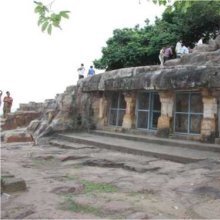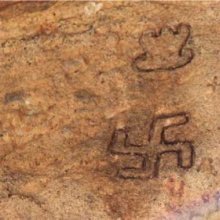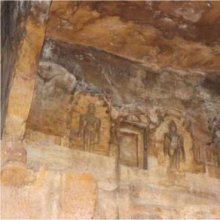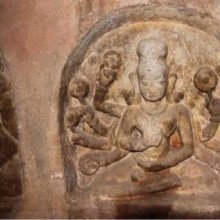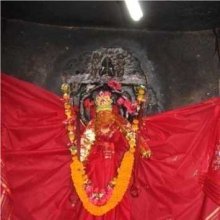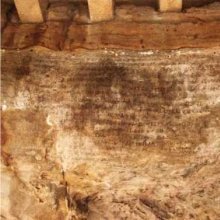Gumpha: 14 definitions
Introduction:
Gumpha means something in Hinduism, Sanskrit, Buddhism, Pali, Marathi, Jainism, Prakrit, Hindi. If you want to know the exact meaning, history, etymology or English translation of this term then check out the descriptions on this page. Add your comment or reference to a book if you want to contribute to this summary article.
Alternative spellings of this word include Gunf.
Images (photo gallery)
(+8 more images available)
In Hinduism
Kavyashastra (science of poetry)
Source: Shodhganga: The Kavyavilasa of Ciranjiva Bhattacarya (kavyashastra)Gumpha (गुम्फ) refers to one of the 93 alaṃkāras (“figures of speech”) mentioned by Cirañjīva Bhaṭṭācārya (fl. 17th century) in his Kāvyavilāsa and is listed as one of the 89 arthālaṃkāras (figure of speech determined by the sense, as opposed to sound).
Cirañjīva has introduced a new figure of speech called gumpha. He defines it as follows—“uttarottarakāryāṇāṃ dhārayā gumpha ucyate”.—“When a series of succeeding effects are described it is the figure gumpha”. Cirañjīva has usually followed Jayadeva in the treatment of figures of speech. But this gumpha is not to be traced in the Candrāloka of Jayadeva. Jayadeva has admitted the figures of speech kāraṇamālā which is very much akin to the figure gumpha of Cirañjīva.
Example of the gumpha-alaṃkāra:—
śrameṇa vidyā’tha tayā vivekastenā’pi dhīrasya vimohabhaṅgaḥ |
utpadyate pūrvajaniprabhūtaprabhūtapuṇye sati satsahāye ||“Learning is acquired by perseverence, and by it conscience grows, again by that destruction of infatuation of the judicious person takes place. All these happen if much virtue acquired in the previous birth be helpful to nobel persons”.
Notes: Here the series of succeeding effects are described. These effects are learning, conscience and dispelling of infatuation generated respectively by perseverence, learning and conscience. So it is an example of gumpha-alaṃkāra.

Kavyashastra (काव्यशास्त्र, kāvyaśāstra) refers to the ancient Indian tradition of poetry (kavya). Canonical literature (shastra) of the includes encyclopedic manuals dealing with prosody, rhetoric and various other guidelines serving to teach the poet how to compose literature.
Languages of India and abroad
Pali-English dictionary
Source: Sutta: The Pali Text Society's Pali-English DictionaryGumpha, see ogumpheti. (Page 252)

Pali is the language of the Tipiṭaka, which is the sacred canon of Theravāda Buddhism and contains much of the Buddha’s speech. Closeley related to Sanskrit, both languages are used interchangeably between religions.
Marathi-English dictionary
Source: DDSA: The Molesworth Marathi and English Dictionarygumpha (गुंफ).—f ē (S) Combings (of śēṇḍī, vēṇī, or hair).
--- OR ---
gumphā (गुंफा).—f (S) pop. guphā f A sylvan abode of a yōgī or devotee; a recess formed by intertwining boughs and creepers; an arbour, a bower. 2 A cavern or cave.
Source: DDSA: The Aryabhusan school dictionary, Marathi-Englishgumpha (गुंफ).—f Combings (of hair).
--- OR ---
gumphā (गुंफा).—f A sylvan abode of a yōgī, a recess formed by intertwining boughs and creepers, an arbour, a bower. A cavern, cave.
Marathi is an Indo-European language having over 70 million native speakers people in (predominantly) Maharashtra India. Marathi, like many other Indo-Aryan languages, evolved from early forms of Prakrit, which itself is a subset of Sanskrit, one of the most ancient languages of the world.
Sanskrit dictionary
Source: DDSA: The practical Sanskrit-English dictionaryGumpha (गुम्फ).—[gumph-ghañ]
1) Tying, stringing together. गुम्फो वाणीनाम् (gumpho vāṇīnām) B. R.1.1.
2) Putting together, composing, arrangement.
3) A bracelet.
4) A whisker, a mustachio.
Derivable forms: gumphaḥ (गुम्फः).
Source: Cologne Digital Sanskrit Dictionaries: Shabda-Sagara Sanskrit-English DictionaryGumpha (गुम्फ).—m.
(-mphaḥ) 1. Tying, stringing as a garland, &c. 2. A bracelet. 3. A whisker, a mustachio. E. gumpha to tie or string, affix ac.
Source: Cologne Digital Sanskrit Dictionaries: Monier-Williams Sanskrit-English Dictionary1) Gumpha (गुम्फ):—[from gumph] m. tying or stringing as a garland, [cf. Lexicographers, esp. such as amarasiṃha, halāyudha, hemacandra, etc.]
2) [v.s. ...] stringing, filing, combining with each other, [Bālarāmāyaṇa i, 1; Kuvalayānanda 289; 319]
3) [v.s. ...] a bracelet, [cf. Lexicographers, esp. such as amarasiṃha, halāyudha, hemacandra, etc.]
4) [v.s. ...] a whisker, [cf. Lexicographers, esp. such as amarasiṃha, halāyudha, hemacandra, etc.]
Source: Cologne Digital Sanskrit Dictionaries: Yates Sanskrit-English DictionaryGumpha (गुम्फ):—(mphaḥ) 1. m. Tying together; a bracelet; a whisker.
Source: DDSA: Paia-sadda-mahannavo; a comprehensive Prakrit Hindi dictionary (S)Gumpha (गुम्फ) in the Sanskrit language is related to the Prakrit word: Guṃpha.
[Sanskrit to German]
Sanskrit, also spelled संस्कृतम् (saṃskṛtam), is an ancient language of India commonly seen as the grandmother of the Indo-European language family (even English!). Closely allied with Prakrit and Pali, Sanskrit is more exhaustive in both grammar and terms and has the most extensive collection of literature in the world, greatly surpassing its sister-languages Greek and Latin.
Hindi dictionary
Source: DDSA: A practical Hindi-English dictionaryGuṃpha (गुंफ) [Also spelled gunf]:—(nm) a string (of words); cluster.
...
Prakrit-English dictionary
Source: DDSA: Paia-sadda-mahannavo; a comprehensive Prakrit Hindi dictionary1) Guṃpha (गुंफ) in the Prakrit language is related to the Sanskrit word: Gimph.
2) Guṃpha (गुंफ) also relates to the Sanskrit word: Gumpha.
Prakrit is an ancient language closely associated with both Pali and Sanskrit. Jain literature is often composed in this language or sub-dialects, such as the Agamas and their commentaries which are written in Ardhamagadhi and Maharashtri Prakrit. The earliest extant texts can be dated to as early as the 4th century BCE although core portions might be older.
Kannada-English dictionary
Source: Alar: Kannada-English corpusGuṃpha (ಗುಂಫ):—
1) [noun] a dimension taken through an object or body or material usu. downward or inward; depth.
2) [noun] the quality of being deep; deepness.
3) [noun] intensity (as of silence).
4) [noun] gravity; seriousness.
5) [noun] intellectual depth; profundity.
--- OR ---
Guṃpha (ಗುಂಫ):—
1) [noun] a tying, stringing together (as a garland) 2) the orderly, logical arrangement of words as to give a sense; agreement of words and sense in a sentence.
2) [noun] the basic structure; the manner in which something is built, constructed or formed.
Kannada is a Dravidian language (as opposed to the Indo-European language family) mainly spoken in the southwestern region of India.
See also (Relevant definitions)
Starts with: Gumphaka, Gumphana, Gumphanem, Gumphani, Gumphanika, Gumphatanem.
Ends with: Aksharagumpha, Kavyarthagumpha, Vaggumpha, Vidhanagumpha.
Full-text (+7): Vaggumpha, Karanamala, Gumphana, Gimph, Gumph, Vidhanagumpha, Kumparkatu, Gunf, Gumphanem, Karakadipaka, Gumphita, Ogumpheti, Kuppam, Guhayati, Guhati, Kommai, Racana, Kuppai, Jali, Kumpam.
Relevant text
Search found 10 books and stories containing Gumpha, Gumphā, Guṃpha; (plurals include: Gumphas, Gumphās, Guṃphas). You can also click to the full overview containing English textual excerpts. Below are direct links for the most relevant articles:
Jainism in Odisha (Orissa) (by Ashis Ranjan Sahoo)
Iconography of Sasanadevis < [Chapter 6]
Iconography of Tirthankaras < [Chapter 6]
Secular and Religious Figurines and Motifs in Jain Art < [Chapter 5]
Sahitya-kaumudi by Baladeva Vidyabhushana (by Gaurapada Dāsa)
Harshacharita (socio-cultural Study) (by Mrs. Nandita Sarmah)
Part 4(b): Bāṇabhaṭṭa: His Style of Writing < [Chapter 1 - Introduction]
Part 5: Cultivation of Knowledge < [Chapter 3 - Education System]
Jnaneshwari (Bhavartha Dipika) (by Ramchandra Keshav Bhagwat)
Verse 18.74 < [Chapter 18 - Moksha-sannyasa-yoga]
Malatimadhava (study) (by Jintu Moni Dutta)
Part 4.3b - Ojas Guṇa (Floridity) < [Chapter 2 - Literary Study of the Mālatīmādhava]
Mudrarakshasa (literary study) (by Antara Chakravarty)
1. Guṇa: It’s classification and components < [Chapter 5 - Adoption of Style and Language in Mudrārākṣasa]
